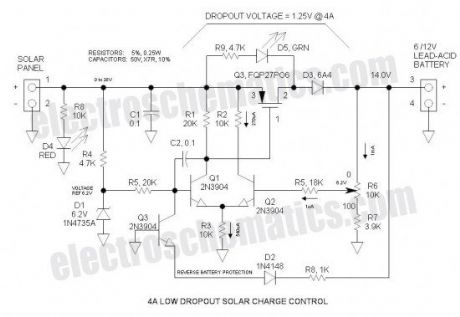Control Circuit
12V LDO Solar Charge Controller
Published:2013/11/5 19:11:00 Author:lynne | Keyword: LDO Solar Charge Controller | From:SeekIC

This Low Dropout Voltage (LDO) solar charge controller uses a simple differential amplifier and series P channel MOSFET linear regulator—their compatibility seems like a marriage made in heaven. Voltage output is adjustable. It is mainly intended for charging 12V lead-acid batteries.
Solar Charge Controller Specifications
Solar panel rating: 50W (4A, 12V nominal) (open circuit voltage: 18 to 20V)
Output voltage range: 7 to 14V (adjustable) (not recommended for 6V applications)
Max power dissipation: 16W (includes power dissipation of D3)
Typical dropout voltage: 1.25V @ 4A
Maximum current: 4A (current limiting provided by solar panel characteristics)
Voltage regulation: 10mV (no load to full load)
Battery discharge: 1mA (Chinese controls discharge at typically 5mA)
LED indicators:
RED: Solar panel active
GREEN: Series regulator limiting current (fully charged or topping off)
Reverse battery protection: Control shuts down if battery is inadvertently connected reverse
12V Solar Charge Controller Schematic
Bill of Materials
In Excel format (download link at the bottom)
Dropout Voltage
The input voltage exceeds the input voltage by 1.25V when charging at the maximum rate—the lower, the better. Low Dropout Voltage (LDO) is the catch phrase for anything under approximately 2V. This could potentially be reduced to below 1V by making D3 a schottky rectifier.
Current Limiting
Current limiting is provided by the solar panel—it is not a commonly understood fact that the solar panel tends to be a constant current device. For this reason, a solar panel can withstand a short circuit. Therefore, the control does not need current limiting.
Float Charge of Lead-Acid Batteries
This control charges the battery at a constant voltage and also maintains a charged battery (float charge). The float charge voltage specification is a little lower than the charge voltage, so to accommodate both voltages, a compromise is reached by simply reducing the voltage slightly—that is how ALL automotive systems operate. To obtain maximum charge in a 12V battery, set the control to 14 to 14.6V. Automotive systems further reduce voltage to 13 to 13.5V in order to accommodate high temperature operation as the battery is usually located in the hot engine compartment—battery has a negative thermal coefficient of voltage.
Voltage Adjustment
To set the voltage, disconnect the battery and connect a 1K dummy load resistor to the output. The resistor is necessary to shunt potential MOSFET leakage current as well as the green LED current.
LDO Solar Charge Control Circuit Operation
R4 and D1 form a 6V shunt zener voltage reference. Q1 & Q2 make up the classic differential amplifier that amplifies the difference between the reference voltage and the feedback voltage from the arm of potentiometer R6. The output is taken from the collector of Q1 and drives the gate of P Channel MOSFET Q3. Differential voltage gain is probably in the order of 100 to 200. For best performance, I selected Q1 & Q2 for matched hFE. As the feedback voltage increases at the arm of R6, Q2 turns on harder and steals some of the emitter current away from Q1. The collector current of Q1 follows the emitter current and drops less voltage across R1 thus reducing Vgs of Q3 and turning it off. C2 provides frequency compensation to prevent the amplifier from oscillating.
Q3 is dormant unless the battery is connected reverse—should this happen, Q3 turns on and reduces the reference voltage input to zero thus turning Q1 & Q3 and preventing damaging battery current.
D3 prevents the battery voltage from appearing across an inactive solar panel.
Thermal Management
This is a linear series regulator that dissipates significant power when the pass transistor is both conducting current and dropping voltage simultaneously—during maximum charge rate when the voltage drop is low, the heatsink runs warm—when the battery is fully charged and there is low charge current, the heatsink is cold—but when the battery starts to top off at maximum voltage, the heatsink runs very hot—such is the nature of a linear regulator. At 4A, Q3 drops 3.3V (assuming solar panel voltage is 18V)(the remaining 0.7V is the D3 voltage drop. P = 4A * 3.3V = 13.2W. The heatsink is rated at 3.9°C/W, so heatsink temperature rise = 13.2W * 3.9°C/W = 51.5°C. Adding the 25°C ambient temperature results in a heatsink temperature of 76.5°C. While this may seem very HOT to the touch, it is still cool to the transistor that is rated for a junction temperature of 175°C.
For the Future
A 6V version—while this control may be adjusted down to 7V for charging 6V batteries, the performance is marginal, but will function at reduced current. A 6V version is on the drawing board.
Photo
Perf board—sorry, no circuit board artwork at the time of publication.
Reprinted Url Of This Article:
http://www.seekic.com/circuit_diagram/Control_Circuit/12V_LDO_Solar_Charge_Controller.html
Print this Page | Comments | Reading(3)

Article Categories
power supply circuit
Amplifier Circuit
Basic Circuit
LED and Light Circuit
Sensor Circuit
Signal Processing
Electrical Equipment Circuit
Control Circuit
Remote Control Circuit
A/D-D/A Converter Circuit
Audio Circuit
Measuring and Test Circuit
Communication Circuit
Computer-Related Circuit
555 Circuit
Automotive Circuit
Repairing Circuit
Code: